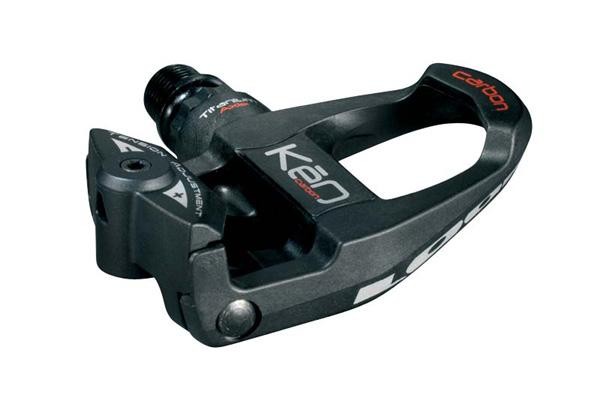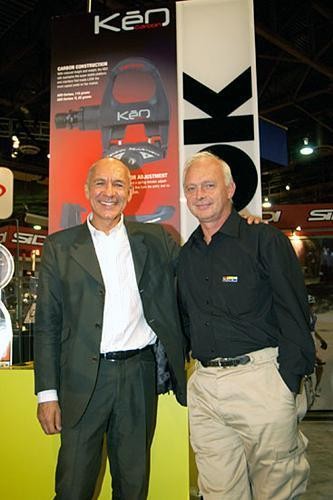Looks the same, but it's different
It's not every day that one of cycling's classic components gets redesigned from scratch....


Tech feature - November 24, 2004
It's not every day that one of cycling's classic components gets redesigned from scratch. Cyclingnews talks to Thierry Fournier, one of the developers of Look's new Keo pedal about the things you can and can't change when you tweak an industry standard.
The French executives looked very confident, smug even. Few companies can claim to have developed a de facto standard in the bike industry, such as Look's three-hole pattern for clipless pedal cleat attachment. Few companies have the same experience in building bicycles made out of composite materials.
But they were in the US not to rest on their laurels, but promote their wares, like all other vendors. And in 2004, they had something special - a new pedal design.
"The research and development on the new pedal began three years ago," said Dominique Bergin, president of the French company. "The market was asking for something lighter, so we decided to create a new standard; something very new and very light. So our challenge was to make smaller the best pedal, but keep the hole pattern the same," he said.
"It was a constraint and an advantage, all at the same time," added Thierry Fournier. The directeur general of Look - and a "father of the new pedal", said Bergin - was commenting on developing the new pedal that retained the same three-hole pattern of the original clipless pedal developed back in the '80s.
"We wanted to keep the Look shape recognizable; it's one of the best pedals and we wanted to improve on it, to make it smaller and lighter," he said.
The latest race content, interviews, features, reviews and expert buying guides, direct to your inbox!
He realized that launching a new pedal system with an incompatible cleat attachment pattern would pose a few challenges, given the virtual standardization of the original Look pattern. Now, almost every cycling pedal and shoemaker in the world has to accommodate this pattern.
The decision by another venerable French manufacturer, Carnac, to abandon its system of inserts in favour of a single-piece carbon fibre sole with a 'standard' three-hole pattern is further acceptance of this approach; first-mover advantage, you could say.
While Look would argue that its original 'Delta-cleat' design was intrinsically a good one, since the release of that first clipless pedal, there have been other successful designs to emerge and continue, ranging from Time to Speedplay through to Shimano, which has created a similar domination of MTB pedals with the SPD system.
Looks the same
"What we have done with the Keo [say kay-oh] is to make it look like a Look cleat and pedal, but everything is different. It's lighter, stronger, and it has three internal bearings, plus the foot is now 6mm lower than the previous design," Fournier said.
Fournier was "not convinced" of the argument that placing the ball of the foot closer to the pedal axle is a more efficient position. "It's not absolutely proven," he said. "Some wanted it to be higher." But nonetheless, Look went with the accepted wisdom from cycle-fit experts.
He said the pedal body is made from the same injected composite material as the existing CX-6 pedal (a 'traditional' Look pedal and said to be choice of professional riders sponsored by the company). "We are not doing something risky [with the Keo]. It has to be of the same standard as the other pedals.
"For sure, we will keep the traditional pattern and pedal, but we'll see how the market responds to the new design. We think the lighter weight and increased contact area are very strong features."
While striving to achieve the lighter weight, Fournier admitted there were some features of the traditional design that could not be accommodated, such as the Q-factor adjustment on the CX-7 and CX-6 pedals.
The Q-factor adjustment in those pedals comes in the form of a pair of 4mm hex screws underneath the pedal that allows the pedal body to be moved sideways, perpendicular to the bicycle. It's Look's way of providing cyclists with another mode of adjustment to compensate for the body's occasional lack of perfect symmetry. The CX-7 pedal also provides another mode of adjustment called 'S.A.T.' - 'for seat angle tuning'.
Fournier said the need for Q-factor-type adjustment was a response to the individual's position on the bike; some riders need more precise adjustment, others get by without it. The other feature of (some models) in the traditional Look pedal range is the float adjustment, where an adjustment key at the rear of the pedal allows for a fixed position (zero float) through to three, six and nine degrees of float.
"Those features need some room," he said, "and we'll probably never do them on the Keo." However, the Keo does have the obligatory spring tension adjustment for cleat retention.
Look's approach to float adjustment with the Keo is to simply offer three different cleats; one has zero float (fixed - a black cleat) while the other two have 4.5 (grey) and 9 degrees (red) of float, respectively.
But it is the increased contact area between the pedal body and the cleat that is one of the Keo's strengths, Fournier said. It's what Look calls the 'bearing surface', that is, the part of the cleat that actually makes contact with the pedal body and transmits the power.
The original 'Delta' cleat provides 213.44 square millimeters of 'bearing surface', whereas the new Keo provides 259.91 square mm. At the same time, the Keo cleat is actually smaller than the Delta.
Overall, the Keo could be viewed as long overdue, given how little Look's design has changed in its essentials since 1984. But Look has been reluctant to tamper with a successful design that created an industry standard - at least in the hole patterns now offered on almost all cycling shoes.
Pedals, cleats and shoes - like helmets and saddles - are cycling products where some designs work brilliantly for one cyclist, but not for another. Then there are those (lucky) cyclists who can use just about anything and not experience any discomfort.
Time will tell if the Keo has the sufficient improvements to make existing Look users upgrade to the new design, and early adopters will closely monitor the wear on the composite pedal body, given the contact is now a plastic-to-composite affair, rather than plastic-to-aluminium. On paper at least, Look has done its homework and evolved what has been one of cycling's most significant developments in 20 years.
A Cyclingnews reviewer is currently testing a pair of the new Keo pedals and that review should appear soon.
